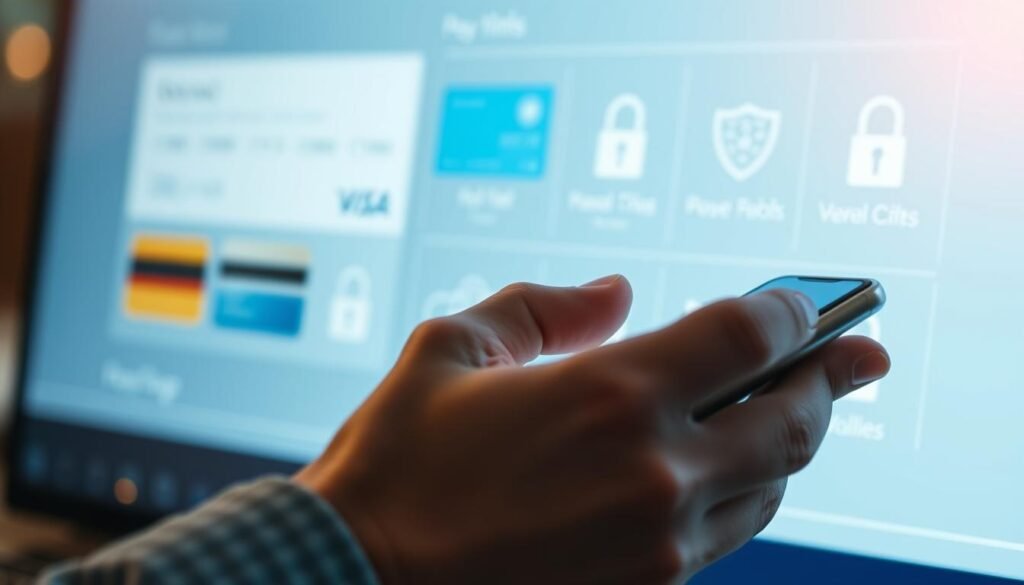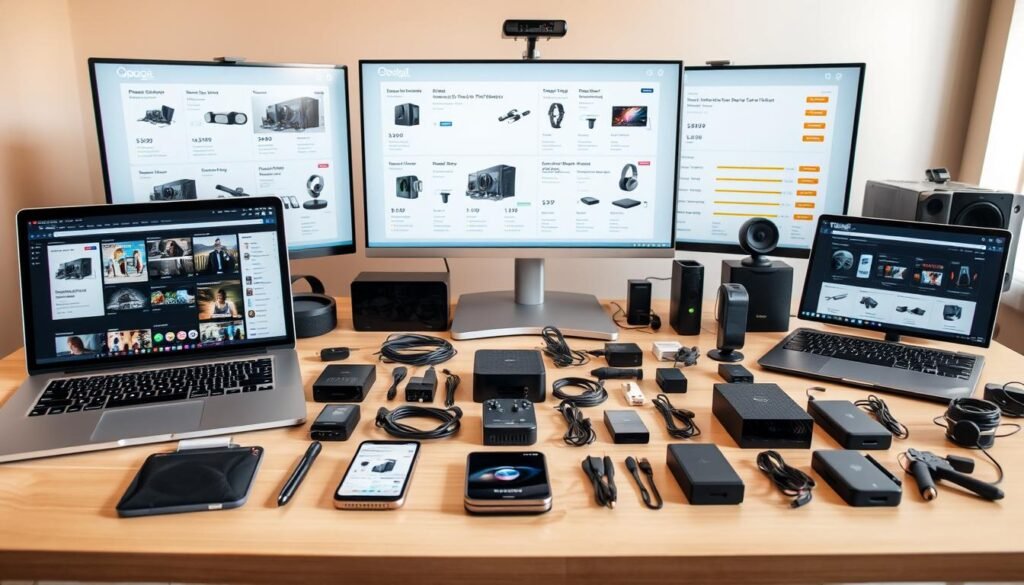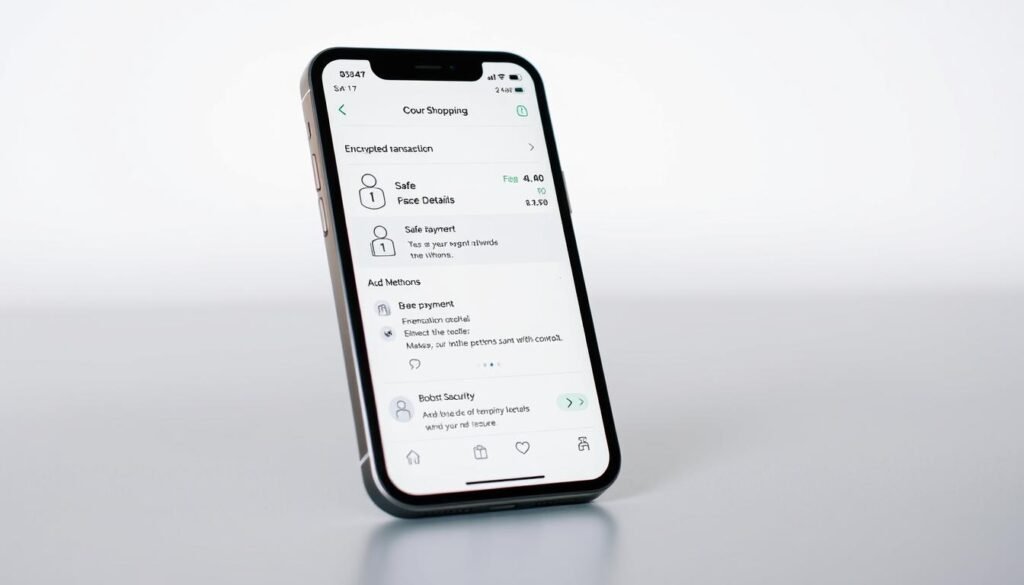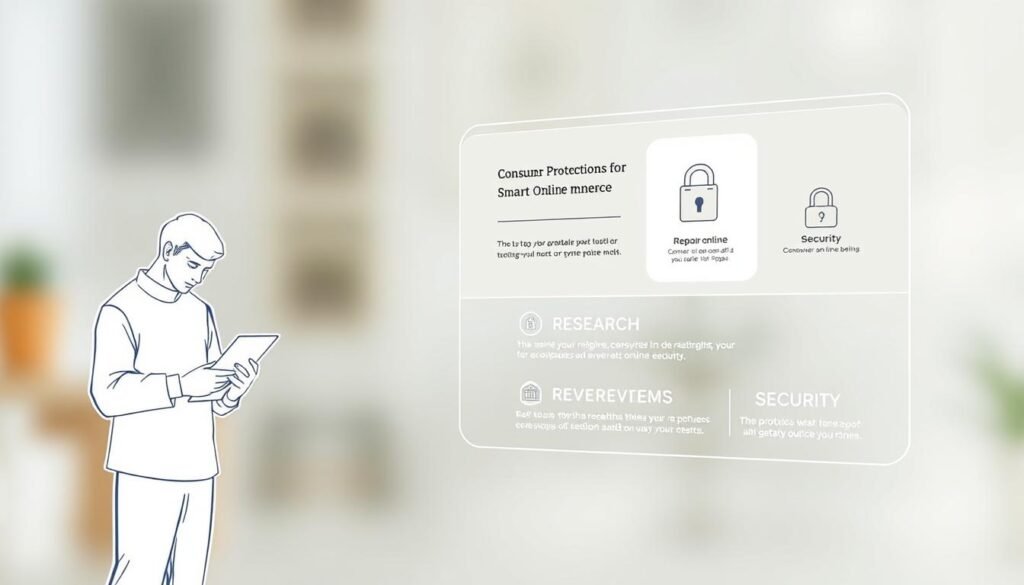“The best investment you can make is in yourself – and that includes learning to protect yourself,” said Warren Buffett. This wisdom is very true today, with all the online shopping.
Every day, millions of Americans look for deals online. But many fall for scams and fraud. Online shopping should be fun, not a worry.
The Better Business Bureau warns about “card declined scams.” Shoppers enter many payment methods, only to be charged several times. The FBI also says non-delivery fraud is the top cybercrime complaint.
But there’s good news: you can be a smart online shopper. This guide will teach you how to protect yourself and find great deals. You’ll learn to avoid scams, keep your payments safe, and find trustworthy retailers.
Are you ready to make your online shopping better? Let’s explore ways to keep your wallet and personal info safe.
Key Takeaways
- Card declined scams are increasing, with criminals charging multiple payment methods simultaneously
- Non-delivery fraud ranks as the most reported cybercrime according to FBI data
- Proper verification techniques can help identify legitimate retailers before purchasing
- Secure payment methods significantly reduce your risk of financial fraud
- Smart shoppers use specific strategies to protect personal information online
- Learning to spot warning signs prevents costly mistakes and identity theft
1. Build Your Online Shopping Foundation
Setting up right before you shop online can save you money, time, and stress. Smart shopping tips start with a solid foundation. This protects your info and keeps you organized.
Create Secure Shopping Accounts
Your online safety starts with secure accounts and strong passwords. The UK’s National Cyber Security Centre found 23.2 million victims used easy passwords like “123456.” Avoid being one of them.
Password managers create unique, complex passwords for each site. They also store your info safely. Strong passwords should use long phrases, not single words, and never be the same across accounts.
Always enable two-factor authentication. This extra step keeps your accounts safe, even if someone guesses your password.
Set Up Price Tracking Tools
Smart shoppers never pay full price. Price tracking tools and browser extensions watch your favorite items. They alert you when prices drop, so you can get deals easily.
Tools like Honey, CamelCamelCamel, and Keepa track price history and predict sales. They help you find the best deals.
Organize Your Shopping Lists and Wishlists
Good shopping organization stops impulse buys and helps you focus. Make lists for different categories like clothes, electronics, and home items.
Use wishlists on Amazon, Target, and other big sites. Share lists with family for gift ideas and special events.
2. Research Products Like a Pro Before Buying

Smart shoppers spend time on product research to avoid bad buys. They gather info from many sources before buying. This helps make the right choice.
Read Product Reviews Effectively
Not all customer reviews are true. The FTC says some are fake or paid for without saying so. Look for reviews that talk about the product’s good and bad points.
Be wary of reviews that seem too good to be true or have weird patterns. Genuine reviews share both the good and the bad. They also talk about how the product works in real life.
Check Brand Reputation and History
To verify a brand, look beyond their website. Check the Better Business Bureau, Google Reviews, and Yelp. These sites show what customers really think and how problems are solved.
See how long the company has been around and their customer service history. Established brands with lots of positive feedback are usually better.
Use Social Media for Product Research
Social media has real user content that reviews might not. Look for hashtags to find photos and stories from people who bought the product.
See how brands interact with their followers. Active brands that answer questions quickly show they care about their customers.
| Research Method | Reliability Level | Best Used For | Time Required |
|---|---|---|---|
| Official Reviews | Medium | General product feedback | 5-10 minutes |
| Social Media Search | High | Real user experiences | 10-15 minutes |
| Brand Background Check | Very High | Company credibility | 15-20 minutes |
| Multiple Platform Review | Highest | Comprehensive assessment | 20-30 minutes |
3. Master Price Comparison and Deal Hunting
The art of deal hunting turns regular shoppers into money-saving experts. They never pay full price. The internet is full of chances to find better deals. These shopping tips will help you save money on every purchase.
Successful bargain hunters use many strategies to get the best value. They combine technology tools with timing to save more.
Use Price Comparison Websites and Browser Extensions
Price comparison websites help you avoid overpaying. Sites like Google Shopping, PriceGrabber, and Shopping.com show prices from different stores. They help you find the best deals.
Browser extensions take comparison shopping further. Honey, Capital One Shopping, and InvisibleHand scan for better prices. They also track price history to show if current prices are good deals.
Install several extensions for the best coverage. Each tool works with different retailers, so using many ensures you catch all discounts.
Time Your Purchases for Maximum Savings
Buying at the right time can save you a lot of money. End-of-season clearances offer deep discounts on clothing and outdoor gear. Black Friday and Cyber Monday have great deals on electronics and appliances.
Monthly patterns also affect prices. New car models come in fall, making late summer a good time to buy. August is great for back-to-school sales on office supplies and electronics.
Find and Apply Working Coupon Codes
Effective coupon codes hunting requires knowing where to find them. Sites like RetailMeNot, Coupons.com, and manufacturer websites offer real discounts. Always try different codes to find the best savings.
Browser extensions automatically apply coupon codes at checkout. They test multiple codes to find the best discount. This saves you time and ensures you get the most savings.
| Tool Type | Best Options | Key Features | Savings Potencial |
|---|---|---|---|
| Price Comparison Sites | Google Shopping, PriceGrabber | Multi-retailer comparison | 10-30% savings |
| Browser Extensions | Honey, Capital One Shopping | Automatic price tracking | 5-25% savings |
| Coupon Aggregators | RetailMeNot, Coupons.com | Verified discount codes | 15-50% savings |
| Cashback Apps | Rakuten, TopCashback | Purchase rewards | 1-10% cashback |
4. Apply Essential Shopping Tips for Smart Consumers

Building smart consumer habits makes your online shopping safer and more rewarding. These basic steps help protect your money and ensure you get what you want.
Create a Shopping Budget and Stick to It
A solid shopping budget stops you from spending too much. Start by tracking your spending for a month to see your habits.
Use apps like Mint or YNAB to set budgets for different things. These apps send alerts when you’re close to your limits. Make budgets for needs, wants, and seasonal buys like holidays.
The 50/30/20 rule is great for online shopping. Spend 50% on needs, 30% on wants, and 20% on savings. This keeps your shopping fun while keeping your finances healthy.
Avoid Impulse Purchase Triggers
Retailers use tricks to make you buy on impulse. Countdown timers and “limited stock” warnings create fake urgency.
Beat these tricks by waiting 24 hours before buying non-essential items. You’ll often lose the urge to buy.
Unsubscribe from emails that try to sell you things. Only sign up for brands you really need. Shop with purpose, not just because you feel like it.
Understand Return and Exchange Policies
Always check return policies before buying. These policies help when items don’t meet your expectations or arrive damaged.
| Policy Feature | Good Policy | Poor Policy | Red Flag |
|---|---|---|---|
| Return Window | 30+ days | 7-14 days | No returns |
| Return Shipping | Free returns | Customer pays | No shipping info |
| Refund Method | Full refund to original payment | Store credit only | No refund details |
| Item Condition | Original packaging acceptable | Perfect condition required | Vague requirements |
Look for clear return policies on websites. Avoid sites with vague or missing return policies. They might be unreliable sellers.
5. Identify and Avoid Online Shopping Scams
Smart shoppers know how to spot scams before they happen. Online scams are now more complex, looking like real stores. The Better Business Bureau says non-delivery and non-payment are top cybercrime issues for shoppers.
Search engines can sometimes show fraudulent websites at the top. Scammers trick search engines to make their sites look real and popular.
Recognize Fake Websites and Fraudulent Sellers
Real stores have professional websites and good writing. Fraudulent websites have spelling mistakes and bad grammar. These signs mean trouble.
Always check the website’s URL before buying. Scammers use similar names to trick you. Make sure you’re on the right site by typing the URL yourself.
Spot Too-Good-to-Be-True Deals
Prices that are way too low are a big warning. Designer fashion finds at 90% off should make you suspicious. Check prices on other sites to see if they’re real.
Scammers use fake urgency like “Only 2 left!” or countdown timers. Legitimate retailers don’t rush you to buy.
Verify Seller Credentials and Reviews
Checking seller info is key. Look for business details, addresses, and phone numbers. The Better Business Bureau’s site has info on companies.
Review patterns can tell you if a seller is real. Fake reviews often sound the same or lack details. Check reviews on different sites to find the truth.
6. Choose Secure Payment Methods and Protect Your Money

The payment method you choose can make a big difference. It can turn a safe purchase into a financial disaster. Smart payment security means knowing which options protect you best from fraud and unauthorized charges.
Keeping your money safe online starts with smart choices. Each payment method has its own level of security and legal protection.
Select the Safest Payment Options
Credit cards offer the strongest protection for online shopping. The Fair Credit Billing Act limits your liability to just $50 for unauthorized charges on credit cards.
Digital wallets like Apple Pay and Google Pay add extra security. They use device authentication and don’t share your actual card numbers with merchants.
PayPal has buyer protection programs that can help solve disputes. Many online shoppers choose PayPal because it keeps their banking information private from sellers.
Use Credit Cards vs. Debit Cards Strategically
Debit cards are riskier for online shopping because they connect directly to your bank account. If scammers get your debit card information, they can empty your checking account right away.
Credit card protection gives you time to dispute charges before paying your bill. Banks must investigate disputed credit card charges while you’re not responsible for the money.
Use debit cards for ATM withdrawals and in-person purchases. This way, you control the transaction environment.
Set Up Purchase Alerts and Account Monitoring
Enable text or email alerts for all card transactions. Most banks offer instant notifications when your card is used online or for purchases over a certain amount.
Review your statements weekly instead of monthly. Quick detection of unauthorized charges makes dispute resolution much easier.
| Payment Method | Fraud Protection | Dispute Process | Risk Level |
|---|---|---|---|
| Credit Card | $50 max liability | 60 days to dispute | Low |
| Debit Card | Up to $500 liability | 2 days to report | High |
| Digital Wallet | Device authentication | Varies by provider | Low |
| PayPal | Buyer protection | 180 days to dispute | Medium |
7. Discover Amazing Fashion Finds and Accessories
Online fashion shopping lets you find unique pieces and designer items at good prices. You can explore styles from all over the world from your home. But, to shop online well, you need to know how to find what you want.
Knowing about product details, sizing, and authenticity is key. It makes the difference between a great find and a bad buy.
Master Size Charts and Accurate Measurements
Size charts differ a lot between brands and countries. Knowing your measurements is essential for online shopping. Use a flexible measuring tape to measure your chest, waist, hips, and inseam.
Always check the brand’s size guide, not just your usual size. European sizes are smaller than American sizes. Asian brands are even smaller. Pay attention to fit descriptions like “relaxed,” “slim,” or “oversized” to know how it will fit.
Read Fabric and Material Descriptions
Fabric composition tells you how a garment will feel and look. Natural fibers like cotton and wool are breathable but may shrink. Synthetic blends are durable and easy to care for.
Check care instructions carefully before buying. Dry-clean-only items can be expensive to maintain.
Find Authentic Designer Items at Great Prices
Real designer discounts come from sales, outlet stores, and authorized retailers. Compare prices with official brand websites to avoid fakes. Authentic fashion accessories and clothes should match official photos and descriptions.
Fake stores can trick even experienced shoppers. Always buy from verified sellers and trusted platforms. If a deal seems too good, it probably is.
8. Shop Smart for Electronics and Tech Products

Buying electronics online requires comparing features and checking if products are real. The tech market has great deals but also challenges. It’s important to do research and verification before buying.
Knowing the technical details of what you want is key. Whether it’s smartphones, laptops, or smart home devices, understanding what you need helps. This way, you make a smart choice and are happy with your purchase.
Compare Specifications and Key Features
Product specs reveal the truth behind marketing. Look at features that matter to you, not just fancy numbers.
Make a comparison chart with these key areas:
- Performance metrics – processor speed, RAM, storage capacity
- Battery life and charging options for portable devices
- Connectivity features – WiFi standards, Bluetooth versions, ports
- Display quality and size specifications
Check Warranty and Customer Support Options
Warranty shows how confident the maker is in their product. Look for coverage that includes parts, labor, and replacements. Extended warranties from third parties often provide less value than manufacturer coverage.
Check the quality of customer support. Look for fast response times and various contact options. Good support offers phone, chat, and email help.
Avoid Counterfeit Electronics and Accessories
Counterfeit products are dangerous and don’t work well. Real retailers don’t sell genuine products at super low prices. This is a warning sign.
Here’s how to check if a seller is real:
- Look at seller ratings and reviews
- Check if they are authorized dealers
- Look for any packaging mistakes in product photos
Trust your gut when deals seem too good to be true.
9. Navigate Brand Recommendations and Influencer Marketing
Knowing the difference between real recommendations and paid ads can save you money and avoid disappointment. Today, influencer marketing mixes entertainment with ads in ways that aren’t always clear. Learning to spot these differences helps you make smarter choices when buying.
Some online reviews might not be entirely honest. Reviewers might get free products or money without saying so. Critical thinking about recommendations helps protect your wallet and ensures you get what you need.
Evaluate Sponsored Content and Paid Partnerships
Look for words like “sponsored,” “ad,” or “#paid” in posts and videos. The Federal Trade Commission says influencers must clearly mark sponsored content. But, some creators use terms like “gifted” or “collaboration” that aren’t clear.
Notice if influencers suddenly start talking about a product they haven’t mentioned before. Authentic recommendations often come with personal stories of long-term use. Compare their usual content with promotional posts to see the difference.
Find Genuine Brand Recommendations
Check brand recommendations from different sources before buying. Look at reviews on various platforms, not just the influencer’s channel. Look for consistent feedback from different reviewers who aren’t connected.
Choose reviewers who talk about both good and bad points of products. Balanced reviews that mention both pros and cons are usually more trustworthy than just positive content.
Use Influencer Discount Codes Wisely
Always compare influencer discount codes with current sales and other promotions. Sometimes, regular store discounts are better than influencer codes. Use price comparison tools to find the best deal.
Check the expiration dates and terms of discount codes before buying. Some codes only work for first-time customers or have minimum purchase requirements that might not fit your needs.
10. Master Mobile Shopping Apps and Security

Shopping apps are super convenient but need smart security to keep your info safe. Mobile shopping is a top choice for many, from fashion finds to gadgets. But, apps collect your personal details and track your location.
Smart shoppers know how to balance ease with safety. They pick trustworthy apps and guard their personal info during buys.
Choose Legitimate Shopping Apps
Only get apps from trusted stores like Google Play or Apple’s App Store. Check the developer name to make sure it’s the real deal. Look for apps with lots of downloads and great reviews.
Stay away from apps with bad grammar or too-good-to-be-true promises. Real retailers have professional apps and clear contact info.
Secure Mobile Payments and Personal Data
Mobile payments with Apple Pay and Google Pay are safer than cards. They use special security and ask for device checks, keeping you safe from fraud.
Don’t save payment info in unknown apps. Use secure ways to pay and turn on two-factor authentication when you can.
Manage App Permissions and Privacy Settings
Look at what data each app wants before you install it. App security begins with managing what permissions you give. Most shopping apps don’t need your photos or mic.
Check your app permissions in your phone’s settings often. Delete access for unused apps and limit location tracking to what’s really needed.
| Security Feature | High Security Apps | Medium Security Apps | Low Security Apps |
|---|---|---|---|
| Two-Factor Authentication | Always Required | Optional Setting | Not Available |
| Payment Tokenization | Standard Feature | Limited Support | Direct Card Storage |
| Data Encryption | End-to-End | Basic Encryption | Minimal Protection |
| Permission Controls | Granular Options | Basic Controls | All-or-Nothing |
11. Handle Post-Purchase Like a Pro
Your shopping journey doesn’t end when you click ‘buy now’. The post-purchase phase is where smart shoppers truly shine. Managing your purchases effectively after checkout helps you avoid problems and build positive relationships with retailers.
The key to successful post-purchase management lies in staying organized and proactive. Smart shoppers treat every purchase as an opportunity to learn and improve their future shopping experiences.
Stay on Top of Your Deliveries
Effective order tracking starts the moment you complete your purchase. Save all confirmation emails in a dedicated folder. Note expected delivery dates on your calendar.
Use tracking apps like Shop or Aftership to monitor multiple orders from different retailers in one place. These tools send automatic updates and help you spot delivery delays early. Regular monitoring also helps you catch package theft or delivery errors quickly.
Navigate Returns and Refunds Successfully
Understanding the returns process before problems arise saves time and frustration. Take photos of items immediately upon arrival to document any damage or defects.
Contact customer service promptly when issues occur. Be polite but firm, and keep records of all communications. Most retailers want to resolve problems quickly to maintain good customer relationships.
| Return Timeframe | Required Documentation | Refund Method | Processing Time |
|---|---|---|---|
| 7-14 days | Original receipt, photos | Original payment method | 3-5 business days |
| 15-30 days | Order number, reason | Store credit option | 5-10 business days |
| 30+ days | Warranty claim, proof | Manufacturer credit | 10-14 business days |
Write Reviews That Help Everyone
Well-written customer reviews benefit both shoppers and sellers. Focus on specific details about quality, sizing, and performance. Don’t just share emotional reactions.
Include photos when possible and mention how the product compares to your expectations. Honest reviews build trust and often lead to better brand recommendations from retailers. Your feedback helps create a stronger online shopping community for everyone.
12. Conclusion
Smart shopping becomes easy with the right tips. The FBI says non-delivery scams are the top cybercrime. Knowing how to protect yourself is key.
Begin by choosing two or three tips that feel right. Learn about secure payments and how to spot scams first. These basics keep your money safe while you learn more.
Every time you shop online, you get better. Using price comparison tools saves money right away. Learning about products helps you avoid making bad choices.
Getting better at shopping takes time and practice. Every time you shop, you can use new tips. These methods work for finding clothes or comparing electronics.
The online world rewards those who are ready. You’ll have an edge over others by knowing how to find deals and stay safe. Each new skill you learn makes you a smarter shopper.
Are you ready to use what you’ve learned? Pick one tip from this guide and try it next time you shop. You’ll save money and feel more confident in your choices.

